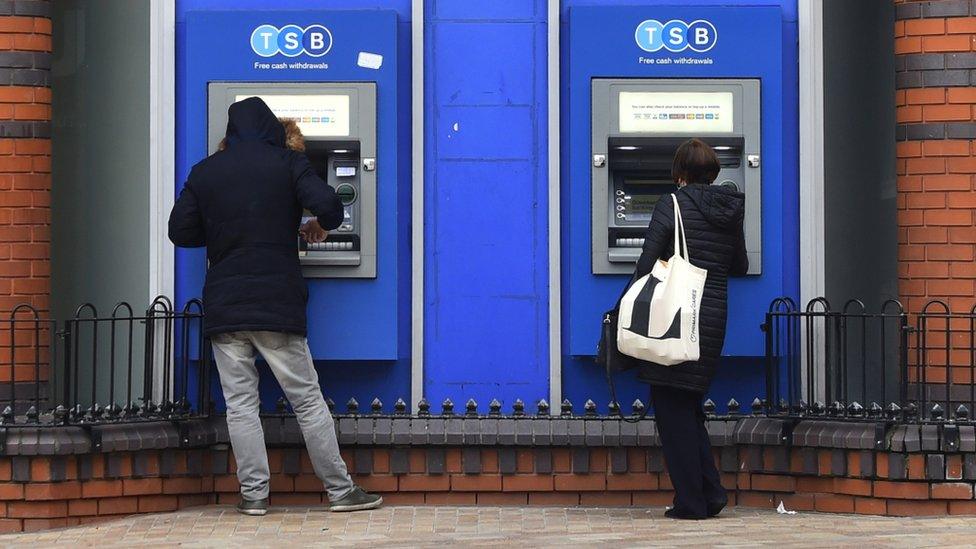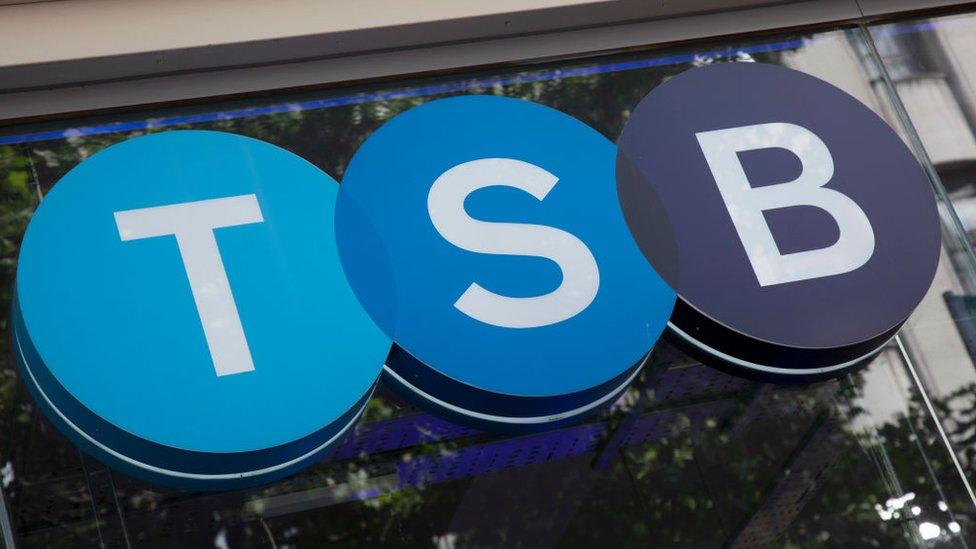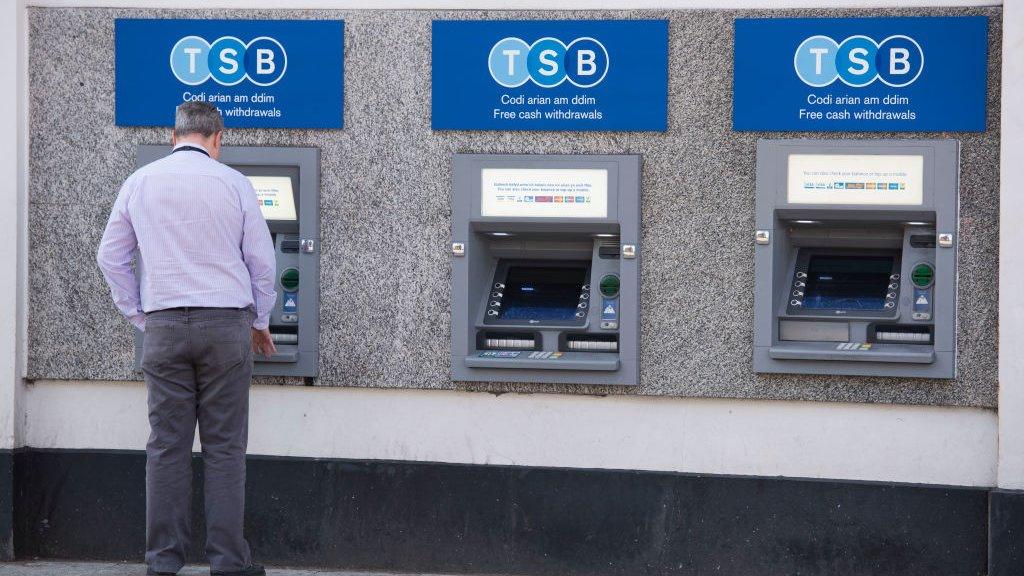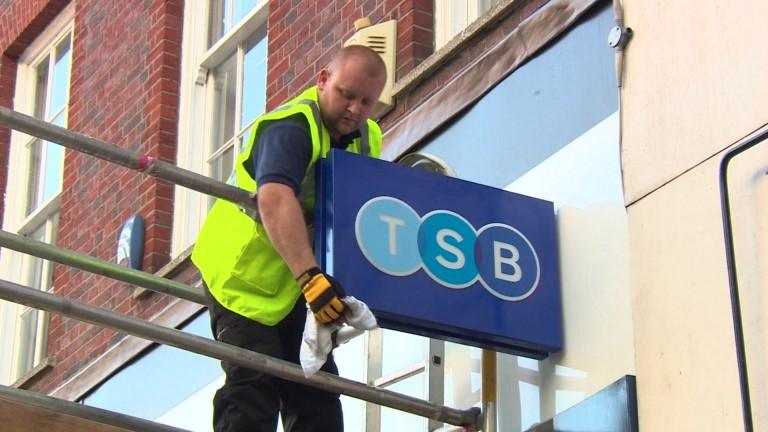Bad loans weigh on bank results
- Published

The reporting season for British finance has begun with TSB announcing a loss, mostly down to an expectation that loans will turn sour.
Other themes to watch are in changing customer behaviour, allowing accelerated branch closures, high levels of savings, demand for mortgages and low returns on record low interest rates.
More competition is on the way from JP Morgan Chase, with a vote of confidence in the Scottish financial workforce.
It's February, so it must be time for banks to admit the obscene profits or shattering losses they've sustained, and how much bankers have been paying themselves in outrageous bonuses.
This year is different, however. Where bonuses are paid, they're unlikely to be in the bumper category. Profits and share prices have taken a pounding - partly because of the Covid pandemic, but more because interest rates are so low.
The gap between interest charged to borrowers and interest paid to savers has narrowed. That's where banks usually make their money, and with the base rate at 0.1%, it's tough-going.
They're preparing for the possibility of going further down, and into negative territory. Theoretically paying customers to borrow money and charging them to deposit would be a hard adjustment. And they're testing their computer systems to make sure they don't get confused by the negative numbers.
In arrears

So what else to watch out for? TSB gave us a taste of it with a pre-tax loss of £204m.
Most of that is explained by the accounting adjustment needed for impairments, or bad loans.
Some £164m is in expectation of customers defaulting. And as 92% of TSB lending is in mortgages, the assumption must be that an expectation of rising unemployment and growing distress in household finances is on the way.
Other banks, reporting later this month, will reflect more of the expected defaults on business lending, though a lot of that falls on the UK Government, with its 100% backing for Bounce Bank Loans.
They have been distributed via banks, and there will be an interesting tension between banks and government on how tough they have to be in collecting it.
A further £55m of the TSB one-off impairment bill has come in "relating to the treatment of some customers in arrears". That's a big bill to be putting something right, which suggests it went far wrong.
Dumfriesshire thrift

Then there is restructuring, for which this year's account takes a hit of £90m - double the previous plan.
That means putting 100 more IT engineers into the registered head office in Edinburgh's George Street. It also involves closing 164 branches and shedding 900 people.
A three-year restructure has been accelerated into two years, so those branches are going to close in the next five months.
A high proportion of them - 73 in total - are in Scotland. Of them, seven are in Aberdeen and three nearby. Six are in Glasgow. Others are in smaller communities from Campbeltown to Wick.
That reflects the high count of TSB branches in the country where it all began in 1810, when the Reverend Henry Duncan pioneered the idea of a savings bank to reward the thrift of his parishioners in Ruthwell, Dumfriesshire.
Consumer group Which? reckons Scotland is losing two-thirds of its TSB branches over several years, with half in England and 40% in Wales.
The bank responds that even after the closures, its 62 branches will be the third largest network in Scotland. And with 17,000 customers per average branch, it remains better spread than the industry average of around 20,000.
As with other banks, which will no doubt be saying the same later this month, this has to do with changing customer choice and behaviour.
Despite a horror of a migration of IT platforms in 2018 that cost a lot in funds and reputation, TSB has seen a dramatic shift over five years ago. Mid-decade, roughly 80% of products were sold in branches. Now 80% are sold online or on an app.
The pandemic has hurried things along. There has been a 60% drop in transactions carried out in branches during the past ten months.
Some of these numbers reflect shorter opening hours, plus the enthusiastic encouragement of banks to use digital banking rather than branches.
Bank for sale

What we saw from TSB and can expect from others is a sharp increase in savings, up by 13%. Customers have less to spend on, so they're putting funds away. And it's not because of attractive returns on saving accounts. None are on offer.
The mortgage market has also been buoyed, both by people wanting to upshift to homes with more space, now that they face lockdowns and home-working. It is also that rates are low and transaction tax has been reduced.
TSB doesn't have a share price by which its performance can be gauged. It is part of Spanish bank Sabadell, where the chief executive marked his annual results day by saying that his UK operation has not yet been put on the market for sale.
But other banks do have share prices, which have tracked tough times for their customers. Royal Bank of Scotland (now part of NatWest) and Bank of Scotland (part of Lloyds Banking Group) have seen further subdued valuations.
Talk of a sale of the UK Government's 62% stake in NatWest/RBS will probably be raised later this month, but in the current state of the market, it looks even less likely than usual.
Giving Chase

Nevertheless, others see opportunity in UK banking. Foreign banks retreated with the crash 12 years ago. But vast JP Morgan Chase has just announced that it's opening an online retail operation in the next few months.
Under the Chase brand, it has a licence, it'll be based in London and its call centre will be in Edinburgh. Four hundred people have already been taken on and are being trained up. More can be expected to follow.
The American giant, which has 55m US customers, already has more than 2000 IT and back office technicians working in Glasgow, providing for operations around the world. It started there 20 years ago, and seems to like it more and more.
When they're allowed to return to their workplace, they may find the company has moved to a prestigious office block being built in the heart of the city's financial district.
In tough times for banking and the economy, that's a reassuring vote of confidence in the people skills that international banks seek out from the Scottish workforce.
Related topics
- Published30 September 2020

- Published10 August 2020

- Published17 September 2019

